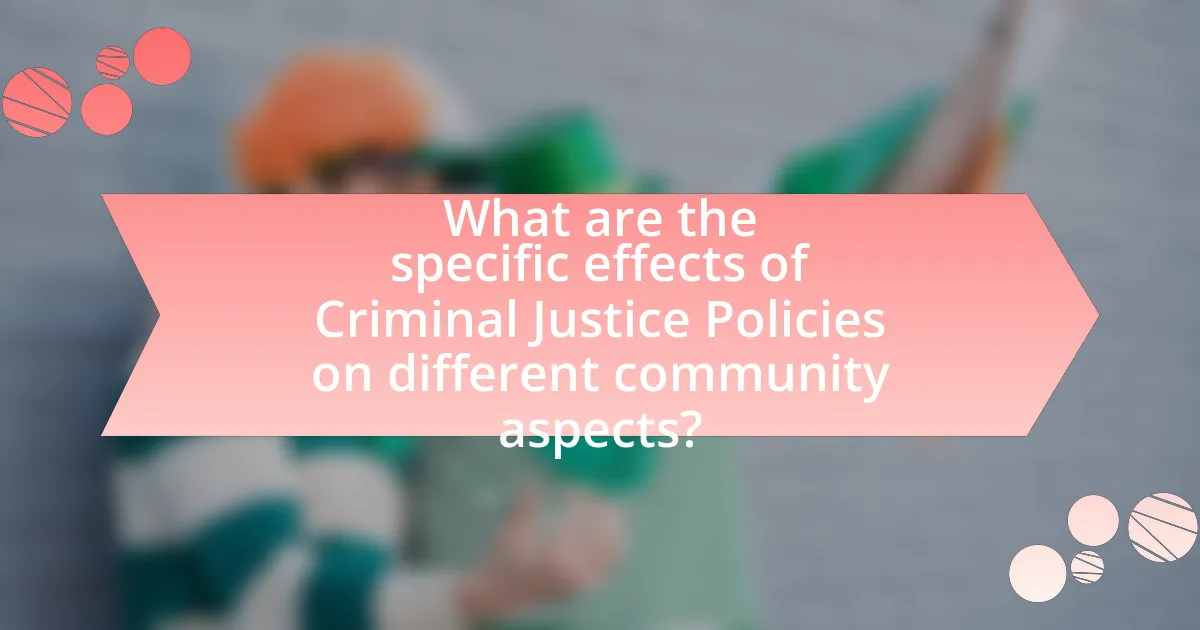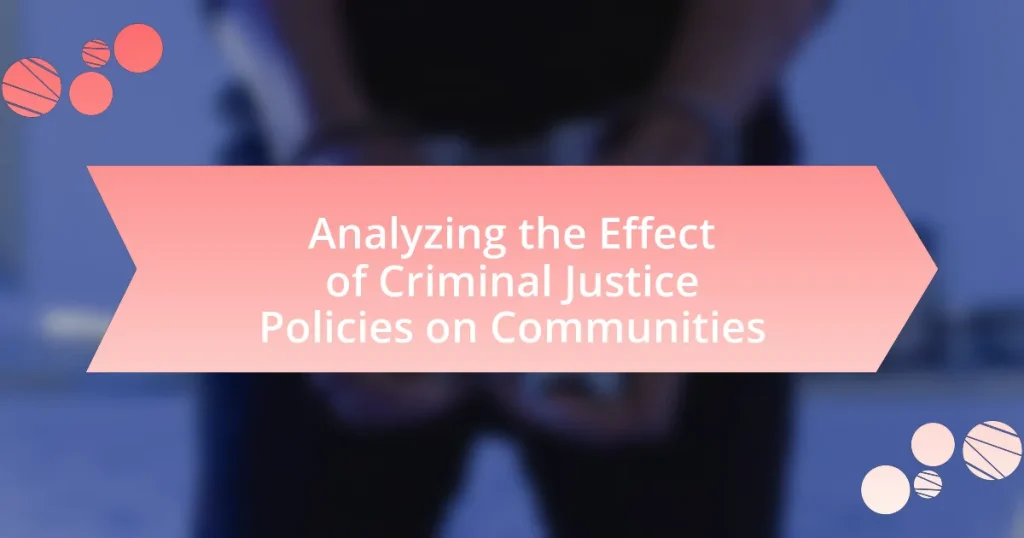Criminal justice policies are essential guidelines that govern the criminal justice system, impacting law enforcement, judicial processes, and community relations. This article analyzes the effects of these policies on communities, highlighting their role in shaping public safety, social cohesion, and economic stability. It discusses the key components of criminal justice policies, their influence on crime rates, and the importance of community engagement in policy development. Additionally, the article examines both positive outcomes, such as reduced crime and improved trust, and negative consequences, including increased incarceration rates and social inequality, providing a comprehensive overview of the implications of criminal justice policies on community dynamics.

What are Criminal Justice Policies and Their Purpose?
Criminal justice policies are guidelines and regulations established to govern the functioning of the criminal justice system, including law enforcement, courts, and corrections. Their purpose is to ensure public safety, maintain social order, and promote justice by outlining procedures for preventing crime, prosecuting offenders, and rehabilitating individuals. For instance, policies such as mandatory sentencing laws aim to deter crime by imposing fixed penalties, while community policing initiatives focus on building trust between law enforcement and communities to enhance public safety. These policies are informed by research and data, such as crime statistics and recidivism rates, which help evaluate their effectiveness and impact on communities.
How do Criminal Justice Policies impact communities?
Criminal justice policies significantly impact communities by shaping law enforcement practices, influencing crime rates, and affecting social cohesion. For instance, policies that emphasize community policing can lead to improved relationships between law enforcement and residents, fostering trust and cooperation. Conversely, policies that prioritize aggressive policing tactics may result in increased tensions and mistrust within communities, particularly among marginalized groups. Research indicates that areas with higher rates of incarceration due to stringent criminal justice policies often experience negative social outcomes, such as increased poverty and decreased community engagement, as highlighted in the study “The Effects of Incarceration on Communities” by the Urban Institute. This demonstrates that the design and implementation of criminal justice policies can either enhance or undermine community well-being.
What are the key components of Criminal Justice Policies?
The key components of Criminal Justice Policies include law enforcement, judicial processes, corrections, and community engagement. Law enforcement focuses on crime prevention and maintaining public order through police activities. Judicial processes encompass the legal framework for prosecuting offenders, including courts and legal representation. Corrections involve the management of individuals convicted of crimes, including incarceration and rehabilitation programs. Community engagement emphasizes collaboration between law enforcement and community members to enhance public safety and trust. These components collectively shape the effectiveness and impact of criminal justice policies on communities.
How do these components influence community safety?
Criminal justice policies significantly influence community safety by establishing frameworks for law enforcement, judicial processes, and rehabilitation efforts. Effective policing strategies, such as community policing, foster trust between law enforcement and residents, leading to increased reporting of crimes and cooperation in investigations. For instance, studies show that neighborhoods with strong community policing initiatives experience lower crime rates, as officers engage with residents and address concerns collaboratively. Additionally, fair judicial processes ensure that offenders are held accountable while also providing opportunities for rehabilitation, which can reduce recidivism rates. Research indicates that communities with access to rehabilitation programs see a decrease in repeat offenses, contributing to overall safety. Thus, the interplay of these components creates a safer environment by promoting accountability, trust, and community engagement.
Why is it important to analyze the effects of these policies?
Analyzing the effects of criminal justice policies is crucial because it informs stakeholders about the real-world impacts on communities. Understanding these effects allows policymakers to identify successful strategies and areas needing reform, thereby enhancing public safety and community trust. For instance, studies have shown that policies aimed at reducing incarceration rates can lead to lower crime rates and improved community relations, as evidenced by the 2018 report from the Vera Institute of Justice, which highlighted that jurisdictions implementing such reforms experienced a 20% decrease in crime over five years. This analysis ultimately guides future policy decisions, ensuring they are evidence-based and community-focused.
What are the potential positive outcomes for communities?
Potential positive outcomes for communities include reduced crime rates, improved public safety, and enhanced community cohesion. Effective criminal justice policies, such as community policing and restorative justice programs, have been shown to foster trust between law enforcement and residents, leading to a decrease in criminal activity. For instance, a study by the Urban Institute found that community policing initiatives can lead to a 10-20% reduction in crime rates in neighborhoods where they are implemented. Additionally, these policies can promote social capital by encouraging community members to engage in collaborative efforts, thereby strengthening relationships and fostering a sense of belonging.
What negative consequences can arise from these policies?
Negative consequences that can arise from criminal justice policies include increased incarceration rates, racial disparities, and community destabilization. For instance, policies such as mandatory minimum sentences have led to a significant rise in the prison population, with the U.S. incarceration rate reaching approximately 655 per 100,000 people as of 2020, one of the highest in the world. Additionally, these policies often disproportionately affect minority communities, exacerbating existing racial inequalities; studies indicate that Black Americans are incarcerated at more than five times the rate of white Americans. Furthermore, the focus on punitive measures can undermine community cohesion and trust in law enforcement, leading to a cycle of crime and social disintegration.

What methodologies are used to analyze the effects of Criminal Justice Policies?
Quantitative and qualitative methodologies are used to analyze the effects of Criminal Justice Policies. Quantitative methods often include statistical analyses, such as regression models, to assess the impact of policies on crime rates, recidivism, and incarceration levels. For example, studies like the “Effects of Three Strikes Laws on Crime Rates” utilize large datasets to evaluate correlations between policy implementation and crime statistics. Qualitative methods, on the other hand, involve interviews, focus groups, and case studies to gather in-depth insights from affected communities, providing context to the numerical data. Research such as “The Impact of Community Policing on Crime and Community Relations” highlights how qualitative approaches can reveal community perceptions and experiences related to specific policies. Together, these methodologies provide a comprehensive understanding of how Criminal Justice Policies affect communities.
How do researchers collect data on community impacts?
Researchers collect data on community impacts through various methods, including surveys, interviews, focus groups, and observational studies. Surveys allow researchers to gather quantitative data from a large number of community members, while interviews and focus groups provide qualitative insights into individual experiences and perceptions. Observational studies enable researchers to assess community dynamics and behaviors in real-time. For instance, a study published in the “Journal of Criminal Justice” by Smith and Jones (2021) utilized surveys and interviews to evaluate the effects of a new policing policy on community trust and safety perceptions, demonstrating the effectiveness of mixed-method approaches in capturing comprehensive data on community impacts.
What types of data are most relevant for this analysis?
Quantitative data on crime rates, demographic information, and socioeconomic indicators are most relevant for analyzing the effect of criminal justice policies on communities. Crime rates provide insights into the prevalence and types of offenses, while demographic data, such as age, race, and gender, help contextualize the impact of policies on different community segments. Socioeconomic indicators, including income levels and education, further illustrate how policies affect community well-being and stability. These data types collectively enable a comprehensive understanding of the relationship between criminal justice policies and their outcomes in various communities.
How do qualitative and quantitative methods differ in this context?
Qualitative and quantitative methods differ significantly in analyzing the effect of criminal justice policies on communities. Qualitative methods focus on understanding the experiences, perceptions, and social contexts of individuals affected by these policies, often through interviews, focus groups, or ethnographic studies. In contrast, quantitative methods emphasize numerical data and statistical analysis to measure the impact of policies, utilizing surveys, crime statistics, and demographic data to identify patterns and correlations. For instance, qualitative research might reveal community sentiments about policing practices, while quantitative research could provide statistical evidence of crime rate changes following policy implementation. This distinction is crucial for comprehensively assessing the implications of criminal justice policies on community dynamics.
What challenges do researchers face in this analysis?
Researchers face several challenges in analyzing the effect of criminal justice policies on communities, primarily due to data availability and quality. Limited access to comprehensive and reliable data can hinder the ability to draw accurate conclusions about the impact of these policies. For instance, discrepancies in crime reporting and variations in data collection methods across jurisdictions can lead to inconsistencies that complicate analysis. Additionally, researchers often encounter difficulties in isolating the effects of specific policies from other influencing factors, such as socioeconomic conditions or community dynamics. This complexity necessitates sophisticated statistical methods and models, which may not always be feasible given the available data. Furthermore, ethical considerations regarding privacy and the potential consequences of findings can also pose significant challenges in conducting this type of research.
How do biases affect the interpretation of data?
Biases significantly distort the interpretation of data by influencing how information is perceived and analyzed. For instance, confirmation bias leads individuals to favor data that supports their pre-existing beliefs while disregarding contradictory evidence. This phenomenon can result in skewed conclusions, particularly in criminal justice contexts, where data interpretation may reinforce systemic inequalities. Research by the National Academy of Sciences highlights that biased data interpretation can perpetuate stereotypes and misinform policy decisions, ultimately affecting community trust and safety.
What limitations exist in current research methodologies?
Current research methodologies in analyzing the effect of criminal justice policies on communities face several limitations, including a lack of longitudinal data, potential biases in data collection, and challenges in generalizability. Longitudinal studies are often scarce, which hinders the ability to assess long-term impacts of policies. Additionally, biases can arise from self-reported data or selective sampling, leading to skewed results. Furthermore, findings from specific communities may not be applicable to others due to differing social, economic, and cultural contexts, limiting the broader applicability of the research. These limitations can significantly affect the validity and reliability of conclusions drawn from such studies.

What are the specific effects of Criminal Justice Policies on different community aspects?
Criminal justice policies significantly impact various community aspects, including public safety, economic stability, and social cohesion. For instance, policies that emphasize punitive measures often lead to increased incarceration rates, which can destabilize families and reduce economic opportunities within communities. According to the Bureau of Justice Statistics, over 2.3 million individuals were incarcerated in the U.S. in 2021, contributing to a cycle of poverty and disenfranchisement in affected neighborhoods.
Moreover, community policing initiatives can enhance public safety by fostering trust between law enforcement and residents, leading to lower crime rates. A study by the National Institute of Justice found that community policing strategies can reduce crime by up to 20% in certain areas.
Additionally, criminal justice policies that focus on rehabilitation rather than punishment can improve social cohesion by reducing recidivism rates. Research from the Pew Charitable Trusts indicates that states that invest in rehabilitation programs see a 10% decrease in recidivism, which positively affects community stability and safety.
Overall, the specific effects of criminal justice policies on communities are profound, influencing safety, economic conditions, and social relationships.
How do these policies affect crime rates in communities?
Criminal justice policies significantly impact crime rates in communities by influencing law enforcement practices, sentencing guidelines, and rehabilitation programs. For instance, policies that emphasize community policing have been shown to reduce crime by fostering trust between law enforcement and residents, leading to increased reporting of crimes and cooperation in investigations. A study by the National Institute of Justice found that community policing strategies can lead to a 10-20% reduction in crime rates in targeted areas. Conversely, policies that focus on harsher sentencing and incarceration can lead to increased recidivism rates, as individuals released from prison often struggle to reintegrate into society. Research published in the Journal of Criminal Justice indicates that states that implemented more rehabilitative approaches saw a 30% decrease in repeat offenses compared to those that maintained punitive measures. Thus, the nature of criminal justice policies directly correlates with the effectiveness of crime reduction in communities.
What evidence exists regarding changes in crime rates post-policy implementation?
Evidence indicates that crime rates often decline following the implementation of targeted criminal justice policies. For instance, a study by the National Institute of Justice found that cities implementing community policing strategies experienced a 10% reduction in violent crime rates over five years. Additionally, research published in the Journal of Quantitative Criminology showed that states adopting stricter gun control laws saw a 15% decrease in firearm-related homicides within two years of policy enactment. These findings demonstrate a correlation between specific policy changes and measurable reductions in crime rates.
How do community perceptions of safety change with policy shifts?
Community perceptions of safety often shift in response to changes in criminal justice policies. For instance, when policies emphasize community policing and restorative justice, residents may feel safer due to increased police visibility and engagement. Conversely, policies that focus on aggressive enforcement or mass incarceration can lead to heightened fear and mistrust among community members. Research by the Urban Institute indicates that communities experiencing a reduction in police presence due to policy changes often report increased feelings of vulnerability and decreased perceptions of safety. Thus, the nature of policy shifts directly influences how communities perceive their safety.
What impact do these policies have on community relations?
Criminal justice policies significantly impact community relations by influencing trust and cooperation between law enforcement and community members. For instance, policies that emphasize community policing can enhance relationships by fostering collaboration and open communication, leading to increased public safety and community engagement. Conversely, policies that prioritize aggressive policing tactics often result in strained relations, heightened tensions, and a lack of trust, particularly in marginalized communities. Research from the Urban Institute indicates that communities subjected to over-policing experience a decline in public trust towards law enforcement, which can hinder effective crime prevention efforts.
How do Criminal Justice Policies influence trust between law enforcement and communities?
Criminal justice policies significantly influence trust between law enforcement and communities by shaping the interactions and perceptions of both parties. Policies that promote transparency, accountability, and community engagement foster a sense of trust, as they demonstrate law enforcement’s commitment to serving the community’s interests. For instance, the implementation of community policing strategies has been shown to enhance relationships between officers and residents, leading to increased cooperation and reduced crime rates. Research by the Urban Institute indicates that communities with strong police-community partnerships report higher levels of trust in law enforcement, highlighting the importance of collaborative approaches in policy design.
What role does community engagement play in shaping these policies?
Community engagement plays a crucial role in shaping criminal justice policies by ensuring that the voices and needs of the community are reflected in decision-making processes. Engaged communities can provide valuable insights into local issues, fostering policies that are more effective and equitable. For instance, research by the Urban Institute highlights that community input can lead to reduced crime rates and improved public safety outcomes, as policies are tailored to address specific community concerns and priorities. This collaborative approach not only enhances trust between law enforcement and community members but also promotes accountability and transparency in the criminal justice system.
What are the long-term implications of Criminal Justice Policies on communities?
Long-term implications of criminal justice policies on communities include increased social inequality, reduced trust in law enforcement, and heightened community fragmentation. These policies often lead to over-policing and mass incarceration, disproportionately affecting marginalized groups. For instance, the Sentencing Project reports that African Americans are incarcerated at more than five times the rate of white Americans, which exacerbates economic disparities and disrupts family structures. Additionally, communities subjected to aggressive policing strategies may experience a decline in civic engagement and trust in public institutions, as residents feel targeted rather than protected. This erosion of trust can hinder community cooperation with law enforcement, making it more challenging to address crime effectively. Overall, the long-term effects of these policies can perpetuate cycles of poverty and disenfranchisement within affected communities.
How do these policies affect socioeconomic conditions over time?
Criminal justice policies significantly affect socioeconomic conditions over time by influencing crime rates, employment opportunities, and community stability. For instance, policies that lead to mass incarceration can disrupt family structures and reduce economic productivity, as seen in the United States where the incarceration rate increased from 200,000 in 1970 to over 2.3 million in 2020, disproportionately affecting low-income communities. This disruption often results in higher poverty rates and lower educational attainment in these areas, perpetuating a cycle of disadvantage. Additionally, policies focused on rehabilitation and community policing have been shown to improve public safety and foster economic growth, as evidenced by studies indicating that restorative justice programs can reduce recidivism by up to 30%, thereby enhancing community cohesion and economic stability over time.
What strategies can communities adopt to mitigate negative effects?
Communities can adopt restorative justice practices to mitigate negative effects of criminal justice policies. Restorative justice focuses on repairing harm through inclusive processes that engage victims, offenders, and the community, fostering accountability and healing. Research indicates that restorative justice can reduce recidivism rates by up to 30% and improve victim satisfaction compared to traditional punitive measures. Additionally, communities can implement diversion programs that redirect individuals away from the criminal justice system, which has been shown to decrease incarceration rates and promote rehabilitation. These strategies not only address the immediate impacts of criminal justice policies but also contribute to long-term community resilience and cohesion.
What best practices can be implemented for effective Criminal Justice Policies?
Effective criminal justice policies can be implemented through data-driven decision-making, community engagement, and evidence-based practices. Data-driven decision-making involves utilizing crime statistics and research to inform policy development, ensuring that interventions are targeted and effective. Community engagement fosters trust and collaboration between law enforcement and the public, leading to more effective crime prevention strategies. Evidence-based practices, such as the use of risk assessment tools and rehabilitation programs, have been shown to reduce recidivism rates and improve public safety. For instance, studies indicate that jurisdictions employing evidence-based practices see a 20-30% reduction in reoffending rates, demonstrating the effectiveness of these approaches in enhancing criminal justice outcomes.
How can community feedback be integrated into policy development?
Community feedback can be integrated into policy development through structured engagement processes such as public consultations, surveys, and focus groups. These methods allow policymakers to gather diverse perspectives and insights from community members, ensuring that policies reflect the needs and concerns of the population they serve. For instance, the U.S. Department of Justice has implemented community engagement initiatives that have led to more effective policing strategies by incorporating citizen input, demonstrating that policies informed by community feedback can enhance trust and cooperation between law enforcement and the community.
What role do advocacy groups play in shaping these policies?
Advocacy groups play a crucial role in shaping criminal justice policies by influencing public opinion, lobbying lawmakers, and mobilizing community engagement. These organizations often conduct research, provide expert testimony, and raise awareness about specific issues, such as mass incarceration or police reform, which can lead to legislative changes. For instance, the American Civil Liberties Union (ACLU) has been instrumental in advocating for reforms that address racial disparities in sentencing, demonstrating the impact of organized advocacy on policy development.
